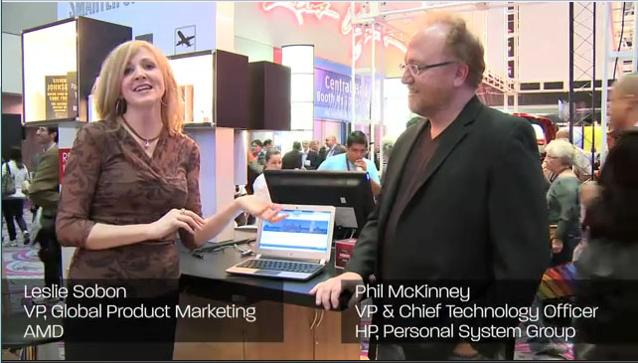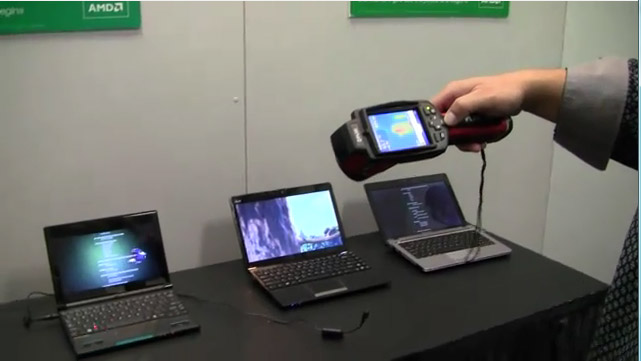
|
TopNax |

|
A Supercomputer in Your NoteBook |
|
January 26, 2011 by Leslie Sobon |
|
We witnessed something of superhero status earlier this month at the 2011 Consumer Electronics Show (CES) – the launch of AMD Fusion Family of APUs packed 90 gigaflops of compute capability – 18 watts of supercomputing – into a tiny, 72 square millimeter of dual core silicon. Just take a look at the beautiful HP Pavilion dm1. At 11.6” it’s ultrathin and ultracool -- both to look at and to touch. It can render in 1080p. It can flawlessly make panorama photos. It can play all your favorite games. And – as my nerd friend Darren Gladstone from HP says in his recent blog – it offers up to 10 hours of battery for less than $500. |

|
This is the beginning of the future of personal computing. With AMD Fusion APUs, technology can adapt to and augment our human experiences. That means 3D and HD everywhere in smaller and smaller devices with unbelievably long battery life. |
|
AMD Fusion delivers the “Trinity for power” |
|
January 24, 2011 by Godfrey Cheng |
|
I would like to start off by stating that this blog is not about the Holy Trinity nor a rumored AMD project nor the Cajun trinity of onions, bell peppers and celery that is used in so many delicious dishes. With the C-30, C-50 and E-350 AMD Fusion line of APUs, we have delivered a state-of-the-art processor that provides excellent compute, graphics and video capabilities with excellent low power consumption. While AMD has always enabled excellent x86, graphics and video performance, we must be honest and state that we have been criticized for our power consumption, heat and battery life. AMD over the past year has made tremendous progress on these fronts. With our AMD Fusion line of APUs, we are taking our low power to a new level while still enabling the great x86, graphics and video experience that is expected of AMD. In lowering the power consumption of our APUs, we also provide what we call the “trinity” of low power consumption, extended battery life and improved thermals. Each is a facet of our lower power consumption but each delivering a separate and tangible benefit. 1. Low Power Consumption: Depending on how power is measured, an AMD Fusion-powered notebook is pulling as little as 30 watts from the socket in the wall. To put that in perspective, we are enabling a supercomputer level of performance at lower power levels than a 40 watt light bulb! Imagine a company with hundreds or thousands of these computers, not only would there be a cost savings for the company but the overall carbon footprint for that company would be reduced. 2. Extended Battery Life: AMD notebooks now deliver excellent x86, Graphics and Video and over 9 hours of battery life, depending on how you use the device. This means that you can have the capabilities of a full blown notebook and almost treat it like a smartphone – charge it just once a day and get rid of the wall wart. 3. Thermals: Huh? The more power a processor consumes, the more heat it generates and dissipates. This part of the equation is often overlooked. With the AMD Fusion APU, we have integrated a modern low power x86 CPU, DirectX 11-capable GPU, Video processor and the north bridge. We have both a 9 Watt and 18 Watt variant shipping today with full systems under 30 watts. For your reference, modern graphics cards consume as much as 300 watts, an order of magnitude difference. At CES this year, we had the challenge of showing lower power consumption for devices powered by the AMD Fusion APU. This is not an easy thing to do actually. We could attach a power meter to the wall….yeah, boring. We could try to show battery life… have people wait for 9-10 hours while the battery drains, yeah, if you really want we can arrange this for you. We bought a thermal camera instead to demonstrate one part of the trinity. Recall the higher power consumption of a computer, the higher the heat generated and dissipated. With our thermal camera we were able to show that not only can our AMD Fusion APUs do things like playback HD video, but we did it cooler than a competitive platform. The obvious benefit is that when you put one of our notebooks on your lap, it does not get as hot as platforms that consume more power. Cooler notebook, cooler lap, better experience. Check out the coverage at AnandTech and HotHardware. I had lobbied to state that due to their lower heat “at the lap” these AMD APU-powered notebooks can actually help improve sperm count but that was shot down by Legal, as I would have had to include an asterisk and note that this statement was not applicable to women……yeah….Legal departments, they are funny in their own way. |
AMD Compares Brazos Fusion APU Thermals, Throws Water On Atom |
|
One of the common concerns among users of AMD’s previous-generation mobile platforms is that they tend to run relatively hot in comparison to many of Intel’s offerings. And we’re not necessarily talking just about chip temperatures either, but rather the heat that radiated out to the notebook’s or netbook’s keyboard and chassis that could be felt by end users on their laps, hands, etc. |
|
January 06, 2011 - by Dave Altavilla and Marco Chiappetta |

|
In the demo, Godfrey Cheng of AMD scans a table with a thermal imaging camera, covered with a quartet of notebooks / netbooks—one Intel based and three AMD based--that are all looping the same 1080P video. As the thermal imaging sensor scans across the machines, it shows the AMD Fusion based products running in the 90’F-98’F degree range at their hottest points, while the Atom-based machine hit over 99'F. |
